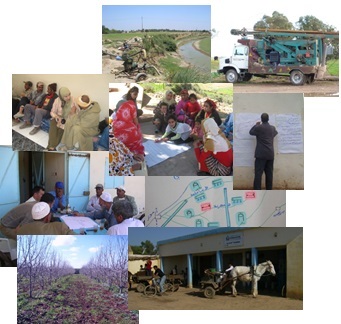Mohamed Taher Sraïri, Moussaab Marouani, Lionel Julien
DOI : https://doi.org/10.60569/hsoas-a2
Numéro 10, dossier thématique oasis, juin 2024
Résumé
Au Maroc, l’élevage demeure une activité fondamentale dans les réalisations du secteur agricole, encore plus dans les zones arides et semi-arides. En vue d’en évaluer les performances technico-économiques et leurs facteurs de variation, cette étude a été réalisée sur un échantillon de 35 exploitations agricoles dans les oasis de montagne au Maroc (communes de M’semrir et Tilmi – Haut Atlas central -). Cet échantillon reflète la diversité des situations locales, avec une répartition entre exploitations transhumantes et sédentaires situées à plus de 1 900 mètres d’altitude. Les résultats révèlent une forte mobilisation de la main-d’œuvre familiale pour les travaux d’astreinte, représentant près de 97,8 % du total des heures de travail liées au troupeau. Le temps dédié à ce travail varie significativement entre les élevages sédentaires et transhumants, avec en moyenne respectivement 98,5 et 436,5 jours par an. L’autonomie fourragère, évaluée à environ 47 % en moyenne, est dépendante de la surface agricole utile et la taille du cheptel. Les taux de reproduction (mise-bas et avortement) et de mortalité reflètent des contraintes importantes pour le développement de l’élevage dans la zone d’étude. Ils mettent en exergue l’impact de la sécheresse, des insuffisances alimentaires et de l’éloignement des éleveurs de leur troupeau. En termes de revenus, l’élevage génère en moyenne 1 545 DH par Unité de Gros Bétail (UGB). La rémunération du travail en élevage varie considérablement entre les éleveurs sédentaires et transhumants, avec une moyenne journalière de 48 DH, inférieure au salaire minimal agricole garanti (SMAG). Ces résultats soulignent une situation vulnérable, exacerbée par les effets du changement climatique, qui compromettent l’attractivité du travail en élevage en zone de montagne. La limitation des ressources naturelles impacte sérieusement la résilience de l’élevage et la création d’opportunités d’emploi décent. Des actions concertées sont nécessaires pour renforcer la durabilité de l’élevage dans ces régions et assurer des moyens de subsistance viables pour les communautés locales.
Mots clés : méthode « 12 MO », oasis de montagne, paramètres démographiques, rentabilité, travail
تحديات وآفاق تربية الماشية بالواحات الجبلية بالمغرب: الربحية تحت رحمة المناخ
السرايري محمد الطاهر1، مرواني مصعب1،جوليان ليونال2
1معهد الحسن الثاني للزراعة و البيطرة، الرباط، المغرب, 2 المركز الدولي للبحث الزراعي للتنمية، منبوليي، فرنسا
ملخص
في المغرب، تظل تربية الماشية نشاطا أساسيا في إنجازات القطاع الفلاحي، وخاصة في المناطق القاحلة وشبه القاحلة. من أجل تقييم الأداء الفني والاقتصادي وعوامل تباينه، أجريت هذه الدراسة على عينة مكونة من 35 ضيعة فلاحية بالواحات الجبلية بالمغرب (جماعتي مسمرير وتلمي – الأطلس الكبير المتوسط -). وتعكس هذه العينة تنوع الأوضاع المحلية، مع التوزيع بين القطعان المتنقلة والمستقرة الواقعة على ارتفاع أكثر من 1900 متر فوق مستوى سطح البحر. تكشف النتائج عن تعبئة قوية للعمالة العائلية للعناية بالحيوانات، وهو ما يمثل ما يقرب من 97.8% من إجمالي ساعات العمل المرتبطة بالقطيع. ويختلف الوقت المخصص لهذا العمل بشكل كبير بين مزارع الماشية المستقرة والمتنقلة، بمتوسط 98.5 و436.5 يومًا سنويًا على التوالي. ويعتمد الاستقلال العلفي، الذي يقدر بنحو 47% في المتوسط، على المساحة الزراعية الصالحة للاستخدام وحجم الثروة الحيوانية. تعكس معدلات التكاثر (الولادة والإجهاض) والوفيات معوقات كبيرة أمام تطوير تربية الماشية في منطقة الدراسة. وهي تسلط الضوء على تأثير الجفاف ونقص الغذاء وبعد المسافة بين المربين وقطعانهم. ومن حيث الدخل، تدر التربية في المتوسط 1545 درهم لكل وحدة كبيرة من الثروة الحيوانية. و تختلف الأجور مقابل العمل في تربية الماشية بشكل كبير بين مربي الماشية المستقرين والمتنقلين، بمتوسط يومي قدره 48 درهم ولكن هناك اختلافات ملحوظة بين المجموعتين. تسلط هذه النتائج الضوء على الوضع الهش الذي تفاقم بسبب آثار تغير المناخ، مما يضر بجاذبية تربية الماشية في المناطق الجبلية. وتؤثر محدودية الموارد الطبيعية تأثيرا خطيرا على قدرة الإنتاج الحيواني على الصمود وخلق فرص العمل اللائق. هناك حاجة إلى إجراءات منسقة لتعزيز استدامة الإنتاج الحيواني في هذه المناطق وضمان سبل العيش المستدامة للمجتمعات المحلية.
الكلمات المفتاحية: طريقة « 12 مو »، الواحات الجبلية، المعلمات الديموغرافية، الربحية، العمل
Challenges and perspectives of livestock breeding in mountain oases in Morocco: profitability at the mercy of the climate
Abstract
In Morocco, livestock breeding remains a fundamental activity in the achievements of the agricultural sector, even more so in arid and semi-arid zones. In order to evaluate its technico-economic performances and their variation factors, this study was carried out on a sample of 35 farms in mountain oases in Morocco (communes of M’semrir and Tilmi – Central High Atlas -). The study sample reflects the diversity of local situations, with a distribution between transhumant and sedentary farms located at an altitude of more than 1,900 meters. The results reveal a strong mobilization of family labor for work dedicated to rear the animals, representing nearly 97.8% of the total working hours linked to the flocks. The time dedicated to this work varies significantly between sedentary and transhumant livestock farms, with an average of 98.5 and 436.5 days per year respectively. Feed autonomy, calculated as the ratio between net energy from endogenous resources and total net energy ingested, was estimated at around 47% on average. It was dependent on the usable agricultural area and the size of the flocks. The reproduction rates (birth and abortion) and mortality reflect significant constraints for the development of livestock farming in the study area. They highlight the impact of drought, food insufficiency and the distance of breeders from their herd.Animal breeding generates on average 1,545 DH per Livestock Unit (LU). Remuneration of livestock work varies considerably between sedentary and transhumant breeders, with a daily average of 48 DH but significant variations between the two groups. These results highlight a vulnerable situation, exacerbated by the effects of climate change, which hinder the attractiveness of work in livestock rearing in mountainous areas. Natural resources limits directly impact livestock’s resilience and its ability to provide decent work opportunities. Concerted actions are necessary to ensure livestock sustainability in such areas to provide secure livelihoods to local communities.
Keywords: demography parameters, « 12 MO » method, mountain oases, profitability, work

